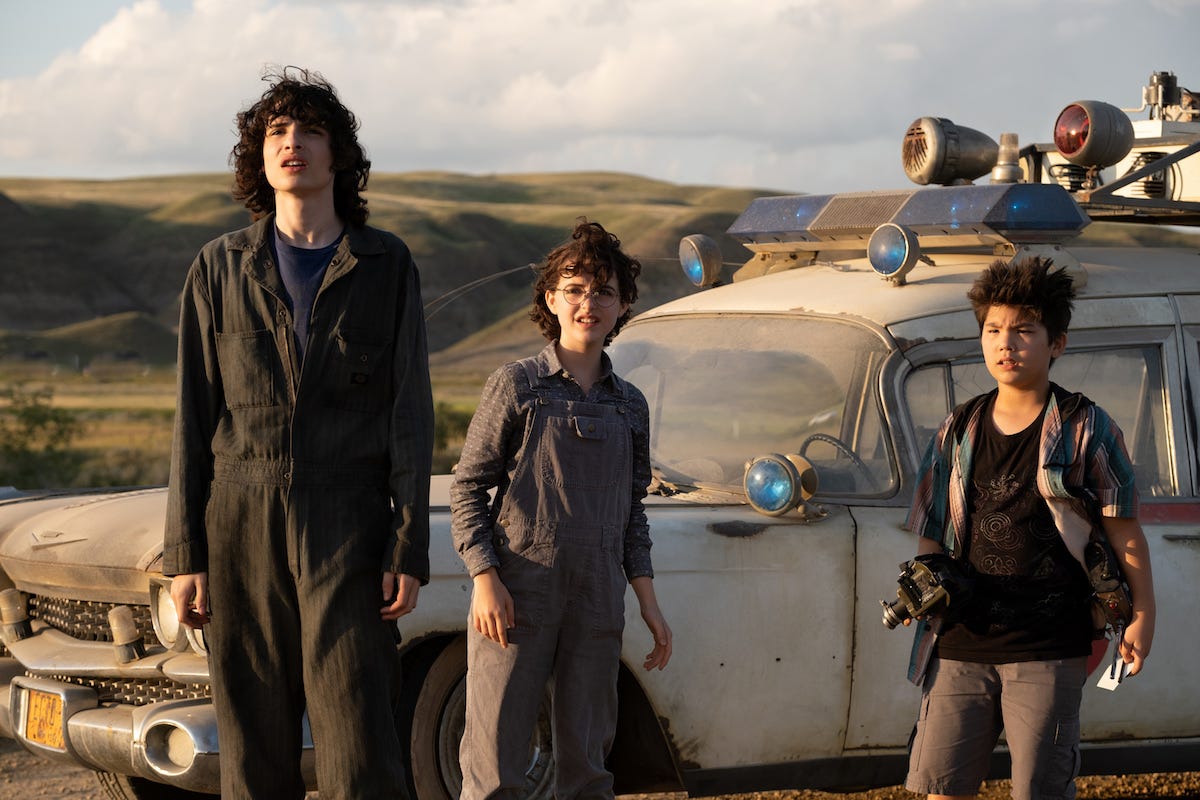‘Ghostbusters: Afterlife’ Review
One hundred percent pure uncut nostalgia.
This review will discuss plot points from Ghostbusters: Afterlife, because it is a review. Please do not angrily email me about spoilers. Trust me: You can’t be spoiled anyway.
I have absolutely no doubt that Ghostbusters: Afterlife will be among the most controversial movies of the year. Not for idiotic reasons that have to do with gender politics and the CHUDs who populate 4chan, or directors sticking their feet in their mouths while trying to defend their soulless piece of commercial product as some sort of statement.
Rather, because Ghostbusters: Afterlife feels like it was created in a lab to trigger all the nostalgia centers in your brain at once. It is both a remake of and a sequel to the original Ghostbusters (the events of the second film don’t even get a mention, as best as I could tell, let alone the 2016 film with the all-female team), a movie that slavishly follows not only the structure but also the plot points and the villains of the original.
But tonally it’s all different. Whereas the first was, more or less, a workplace comedy about grownups trying to find their way in the world, this is a movie about kids trying to save the world. The original featured a gag about Ray Stantz (Dan Aykroyd) getting blown by a succubus as he sleeps in the team’s fire station headquarters; this one features Phoebe (McKenna Grace) making a funny face when she’s told her teacher Gary Grooberson (Paul Rudd) is trying to bang her mom Callie (Carrie Coon). The point of reference here is less Ivan Reitman than Steven Spielberg. There are, weirdly, competing nostalgias struggling against each other. The emotional equivalent isn’t Ghostbusters 1984 so much as it is Super 8 or Tomorrowland.
After a brief prologue in which a shadowy figure tries to trap some ghosts in a dirt field out in the middle of nowhere, we watch as Callie, her daughter, and her son, Trevor (Finn Wolfhard), wind up in that same dirt field. They’re broke; this is the only place they can afford to stay. As they walk in to their dilapidated new home, the camera pans around and we see a pile of books stacked in a way that no human possibly would.
If you’re familiar with the source material, your tolerance for Ghostbusters: Afterlife will largely depend on how badly such things rankle you. The film is an endless flood of manipulative callbacks and reminders of the riverhead from which they flow. If you’re the sort to get agitated because Phoebe pulls a Crunch bar wrapper out of her grandfather’s jumpsuit, this is probably not the movie for you; you will be left aghast by the film’s final scenes.
But if you’re familiar with the source material, you’ve … well, already kind of seen this movie. The whole town of Summerville, Oklahoma was built by one Ivo Shandor (memba him?), who mined selenium (memba that?) to make girders for his apartment building in New York City that was designed to summon Gozer the Gozerian (memba … uh, her?). I hope you memba the Stay Puft Marshmallow Man and the Gatekeeper and the Keymaster, because they’re all here too.

It’s just, well, very strange that writers Jason Reitman and Gil Kenan decided to, functionally, recreate the original film. This isn’t a lazy film in the sense that a movie like Red Notice is a lazy film; there are some really nice shots of Trevor and his new friends enjoying a sunset on top of a mountain covering up an ancient Sumerian sacrifice site (that exists in the middle of Oklahoma, for some reason?), and it’s actually pretty funny. Particularly in the relationship between Coon and Rudd; they’re just very funny together, Coon as the hot, cool mom and Rudd as the hot, cool science teacher. Great chemistry, lots of laughs.
It’s not a lazy film but it is a lazily plotted film in the sense that it’s a carbon copy of the original. As I was exiting the theater, the word that stuck in my mind was cloying. This is a movie that blows right past nostalgia and speeds toward pure, uncut manipulation, keying on all our memories of the original and the actor/writer, Harold Ramis, whose absence is keenly felt throughout. If I were in a slightly different mood—if I were feeling a bit grumpier; if I had primed myself to hate it—there’s a decent chance this review would be viciously negative, a denunciation of the manner in which corporate entities know no boundaries of taste or decency, a cri de cœur against a dying industry’s self-destructive reliance on cannibalizing its past.
But the other thing I felt as I left the theater was … well, happiness. The movie was funny, it looked okay, I enjoyed watching the actors work, and I didn’t even care that there’s a 12-year-old kid called “Podcast” (Logan Kim). At the end of the day, I’m a simple man, with simple tastes and simple pleasures. And Ghostbusters: Afterlife fulfilled my desire to be pleased, simply.



